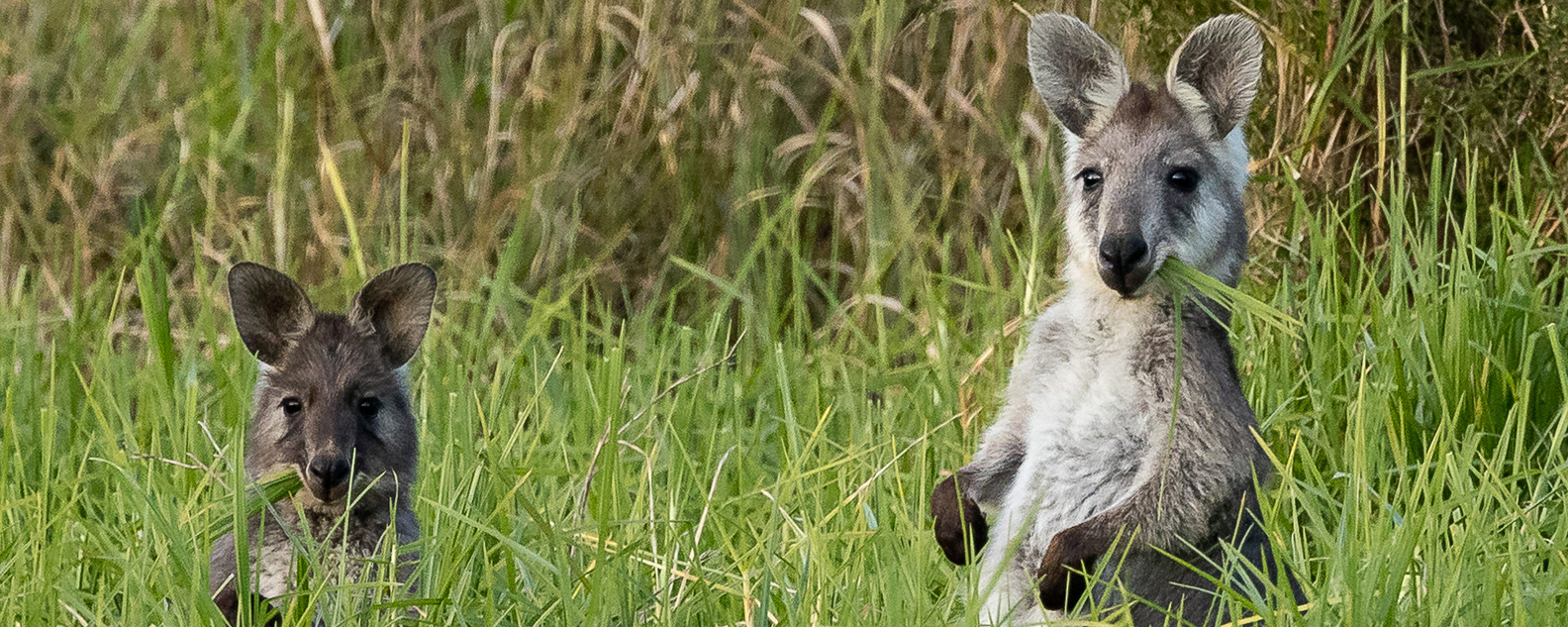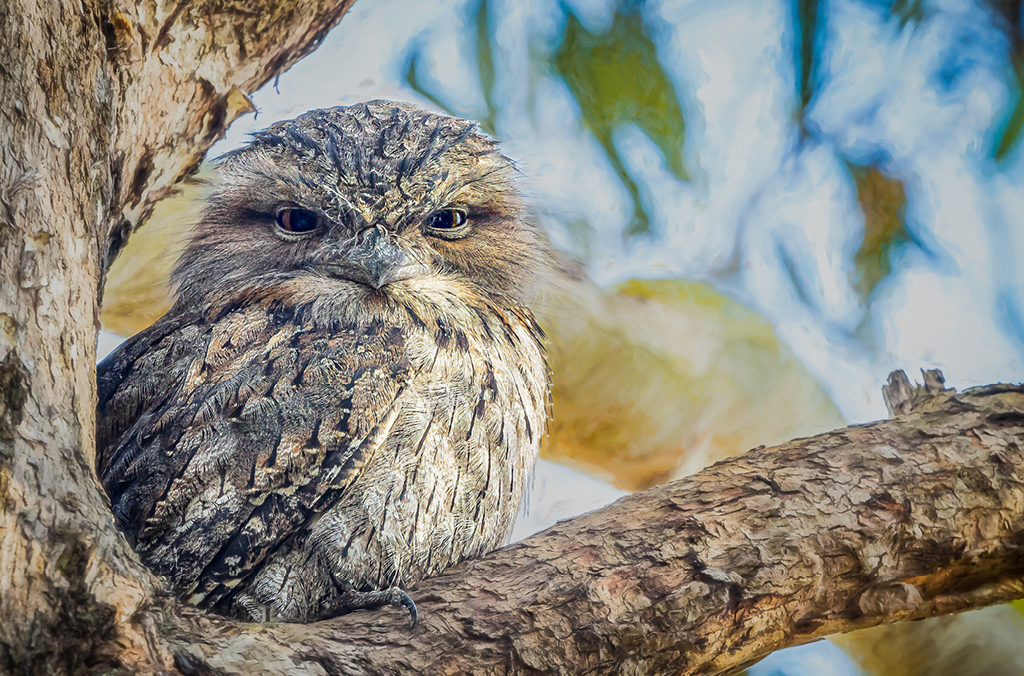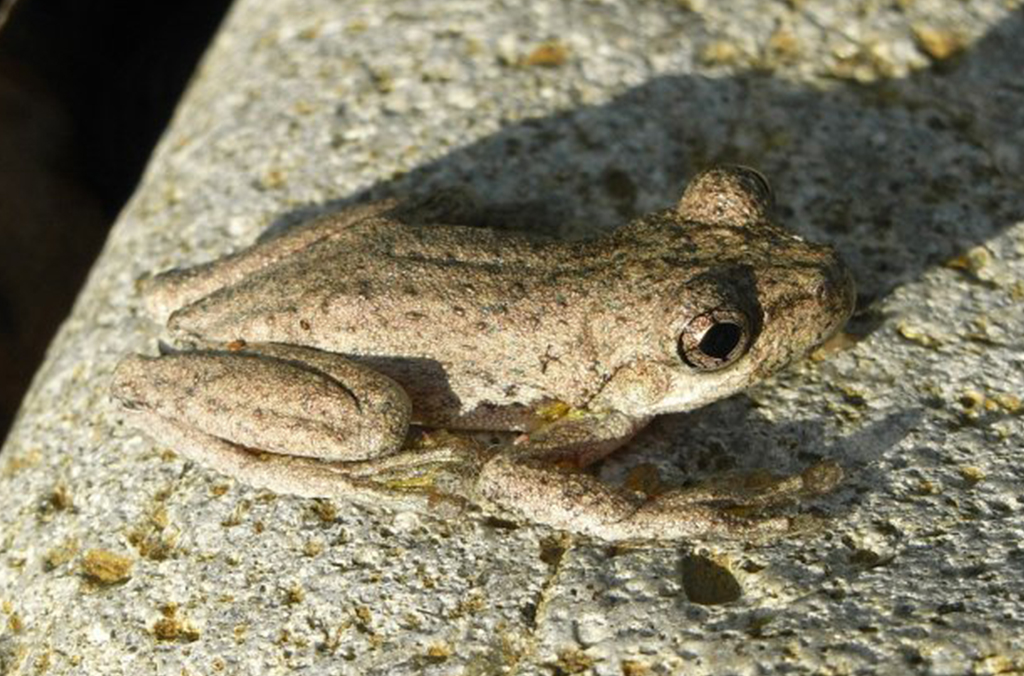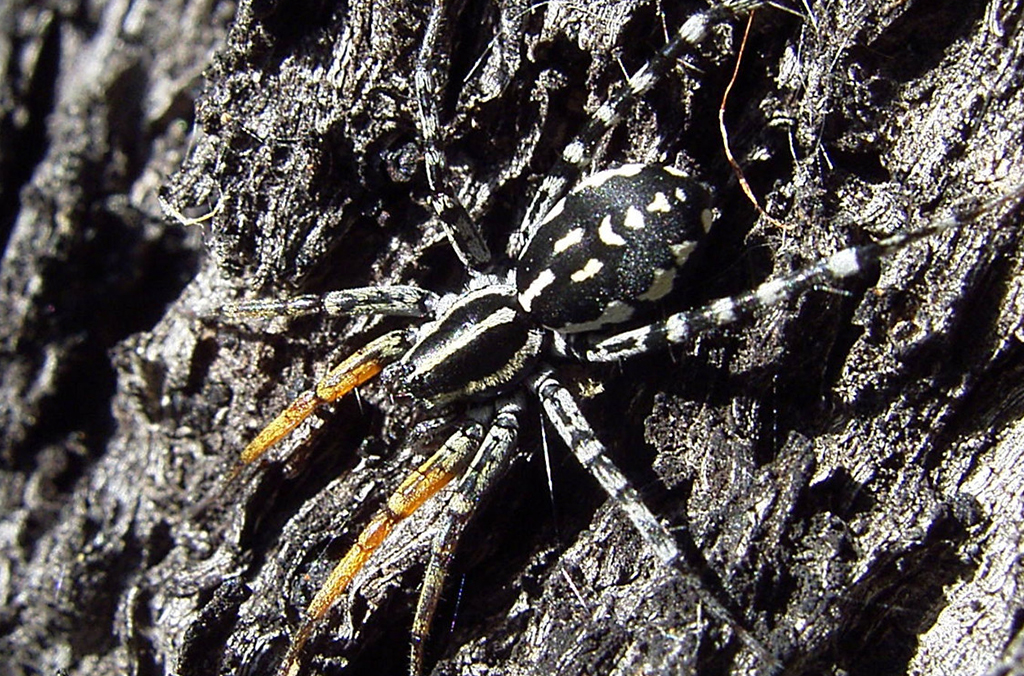Wildlife in the woodland
Seeing animals is always an exciting part of the woodland visit but most are small, shy or nocturnal, and difficult to see. Invertebrates are creatures that you will see, if you look carefully!

Remnants of Cumberland Plain Woodland are an important part of the landscape at the Australian Botanic Garden. Together with native grassland areas (where the trees were cleared during farming times) these natural and semi-natural lands, managed as conservation areas for the local flora and dependent fauna, provide the background setting for the thematic horticultural plantings and amenity areas.
Mammals include Wallaroos and Swamp Wallabies which are mostly seen at dawn and dusk. Reptiles include Bearded Dragon lizards and Red-bellied Black Snakes, which may be seen early on warm sunny days. There are frogs in the ponds which you will hear, but not generally see. Birds are the most conspicuous animals in the woodland.
Invertebrates are creatures that you will see, if you look carefully. Butterflies are common on warm summer days, moths are mostly nocturnal. Colourful beetles may be seen on the plants, along with flies, wasps, bees and ants. Cicadas may be heard high in the trees. Spider webs may cross your path. Other invertebrates include snails - including the Cumberland Land Snail - and worms.
Interactions between plants and animals may be simple one-way activities, particularly predation - animal eating plant, or two-way, animal feeding from nectar and pollinating plant. There may also be more complex interactions such as mealy bug feeding on plant, cared for by ants, while sooty mould is enhanced by mealy bug exudates. Sooty mould debilitates the plant.
Mammals have a major impact by grazing groundcover plants. Wallaroos and Swamp Wallabies are native grazing animals while rabbits have been in the Australian environment since the 1860s. The woodland has also been grazed by sheep, cattle and horses in historic times. Mammals also appear to be significant in seed dispersal. Foxes have been recorded as eating and dispersing the exotic species *Olea europea subsp. cuspidata, African Olive, and *Lycium ferocissimum, African Boxthorn. Many seeds, particularly grass seeds, may adhere to fur and be carried distances. Flying foxes, which may visit the woodland, have been reported to be pollinators of some native species.
Woodland birds are important in seed dispersal and may be involved in some pollination. Birds are reported to pollinate many native species, e.g. species of Grevillea, but these species are not native in the woodland. Plants with fleshy fruits such as Einadia nutans subsp. linifolia, Eremophila debilis, and African Olive *Olea europea subsp. cuspidata are bird-dispersed and are more abundant under large trees.
Insects are important pollinators of both native and exotic species. The introduced Honey Bee *Apis mellifera is very common and pollinates both exotic and native species. Little is known about the pollination of most of the native woodland species.
Insect herbivory has a major impact in the woodland plants. Leaf-eating insects include the larvae of Painted Vine Moth, Agarista agricola feeding on Cayratia clematidea leaves. Periodic defoliation of eucalypts (dieback) occurs when canopy-eating insects build up in unusually large numbers due to particular environmental or climatic conditions.
Seed predation may be direct, or it may be by parasitism whereby eggs are laid in the developing fruit, hatch out and eat seeds within the fruit, e.g. Desmodium brachypodum. While some ant species eat seeds, ants may also move seeds around.
Breakdown of dead plant material by insects such as termites is an important component in recycling of biomass particularly in the absence of fire.
Asterisk * indicates exotic species naturalised at the Australian Botanic Garden.


Peron's Tree Frog
Invertebrates
| Spiders and Scorpions | Phylum: Chelicerata |
| Class: Arachnida | |
| Spiders | Order: Araneae |
| Orb-weaving Spiders | Family: Araneidae |
| Scorpion-tailed Spider | Arachnura higginsi |
| St Andrew's Cross Spider | Argiope keyserlingi |
| Spiny Spider | Austracantha minax |
| Eriophora sp. | |
| Family: Corinnidae | |
| Spotted Ground Swift Spider | Supunna picta |
| Wolf Spiders | Family: Lycosidae |
| Lycosa sp. 2 | |
| Lycosa sp. 1 | |
| Family: Salticidae | |
| Jumping Spider | Sandalodes scopifer |
| Family: Sparssidae | |
| Flat Huntsman Spider | Delena cancerides |
| Four-Jawed or Long-Jawed Spiders | Family: Tetragnathidae |
| Leucauge granulata | |
| Golden Orb Weaver | Nephila edulis |
| Cob-Web Spiders | Family: Theridiidae |
| Red-backed Spider | Latrodectus hasselti |
| Family: Thomisidae | |
| Diaea evanida | |
| Scorpions | Order: Scorpiones |
| Family: Buthidae | |
| Little Marbled Scorpion | Lychas marmoreus |
- Ants, bees and wasps
- Beetles
- Bugs and cicades
- Butterflies and moths
- Cockroaches
- Dragonflies
- Flies
- Grasshoppers
- Earwigs, lacewings, and crustaceans
| Insects and Centipedes | Phylum: Mandibulata |
| Insects | Class: Insecta |
| Cockroaches | Order: Blattodea |
| Family: Blaberidae | |
| Bark Cockroach | Calolampra sp |
| Laxta sp. 1 | |
| Laxta sp. 2 | |
| Family: Blattellidae | |
| Bush Cockroach | Ellipsidion humerale |
| Beetles | Order: Coleoptera |
| Family: Belidae | |
| Belus semipunctatus | |
| Soldier Beetles | Family: Cantharidae |
| Plague Soldier Beetle | Chauliognathus lugubris |
| Family: Cerambycidae | |
| Syllitus sp. | |
| Leaf Beetles | Family: Chrysomelidae |
| Calomela pallida | |
| Callidemum hypochalcum | |
| Dicranosterna immaculata | |
| Pittosporum Beetle | Lamprolina aeneipennis |
| Lema trilineata | |
| Eucalyptus Tortoise Beetle | Paropsis atomaria |
| Eucalypt Leaf Beetle | Paropsis maculata |
| Eucalypt Leaf Beetle | Paropsis variicollis |
| Eucalypt Leaf Beetle | Paropsis variolosa |
| Eucalypt Leaf Beetle | Paropsisterna beata |
| Paropsisterna sexpustulata | |
| Paropsisterna sp. (larvae) | |
| Phyllocharis cyanicornis | |
| Weevils | Family: Curculionidae |
| Diamond Beetle/ Botany Bay Weevil | Chrysolopus spectabilis |
| Eucalyptus Weevil | Gonipterus scutellatus |
| Unnamed weevil | |
| Click Beetles | Family: Elateridae |
| Unnamed Click Beetle | |
| Family: Lycidae | |
| Metriorrhynchus sp. | |
| Porrostoma rhipidius | |
| Scarab Beetles | Family: Scarabaeidae |
| Anoplognathus porosus | |
| Cowboy Beetle | Chondropyga dorsalis |
| Spotted Flower Chafer | Polystigma punctata |
| Unnamed beetle larva | |
| Darkling Beetles | Family: Tenebrionidae |
| Chalcopterus sp. | |
| Snails and Slugs | Phylum: Mollusca |
| Class: Gastropoda | |
| Order: Eupulmonata | |
| Family: Camaenidae | |
| Cumberland Plain Land Snail | Meridolum corneovirens |
| Family: Helicidae | |
| Common Garden Snail | *Helix aspersa |
| Family: Rhytididae | |
| Carnivorous Land Snail | Austrorhytida capillacea |
| Slugs | Family: Limacidae |
| Unknown 1 | |
Find out more about the endangered Cumberland Plain Land Snail including distribution, habitat and recovery planning.
Asterisk * indicates exotic species naturalised at Mount Annan Botanic Garden.
Vertebrates
| Amphibians | Class: Amphibia |
| Frogs | Order: Anura |
| Tree Frogs | Family: Hylidae |
| Bleating Tree Frog | Litoria dentata |
| Eastern Dwarf Tree Frog | Litoria fallax |
| Broard-palmed Frog | Litoria latopalmata |
| Leseur's Tree Frog | Litoria lesueri |
| Peron's Tree Frog | Litoria peronii |
| Verreaux's Tree Frog | Litoria verreauxii |
| Southern Frogs | Family: Myobatrachidae |
| Common Eastern froglet | Crinia signifera |
| Eastern Banjo Frog | Limnodynastes dumerilii |
| Striped Marsh Frog | Limnodynastes peronii |
| Spotted Grass Frog | Limnodynastes tasmaniensis |
| Smooth Toadlet | Uperoleia laevigata |
| Reptiles | Class: Reptilia, Order: Squamata |
| Family Agamidae | |
| Eastern Water Dragon | Physignathus lesueurii |
| Bearded Dragon | Pogona barbata |
| Front-Fanged Snakes | Family: Elapidae |
| Red-naped Snake | Furina diadema |
| Red-bellied Back Snake | Pseudechis porphyriacus |
| Eastern Brown Snake | Pseudonaja textilis |
| Eastern Small-eyed Snake | Rhinoplocephalus nigrescens |
| Family Scincidae | |
| Striped Skink | Ctenotus robustus |
| Eastern Water Skink | Eulamprus quoyii |
| Grass Skink | Lampropholis delicata |
| Garden Skink | Lampropholis guichenoti |
| Eastern Blue-tongued Lizard | Tiliqua scincoides |
| Family Varanidae | |
| Lace Monitor | Varanus varius |
Bird list based on Birds of Mount Annan Botanic Garden by A.J. Leishman (March 2006).
| Birds | Class: Aves |
| Pheasants, Quail | Family: Phasianidae |
| Brown Quail | Coturnix ypsilophora |
| Order: Anseriformes | |
| Ducks, Geese and Swans | Family: Anatidae |
| Musk Duck | Biziura lobata |
| Black Swan | Cygnus atratus |
| Paradise Shelduck | Tadorna variegata |
| Australian Wood Duck | Chenonetta jubata |
| Freckled Duck | Stictonetta naevosa |
| Mallard | Anas platyrhynchos |
| Pacific Black Duck | Anas superciliosa |
| Grey Teal | Anas gracilis |
| Cheastnut Teal | Anas castanea |
| Australian Shoveler | Anas rhynchotis |
| Hardhead | Aythya australis |
| Order: Podicipediformes | |
| Grebes | Family: Podicipedidae |
| Australasian Grebe | Tachybaptus novaehollandiae |
| Hoary-headed Grebe | Poliocephalus poliocephalus |
| Great-crested Grebe | Podiceps cristatus |
| Order: Pelecaniformes | |
| Cormorants | Family: Phalacrocoracidae |
| Little Pied Cormorant | Phalacrocorax melanoleucos |
| Little Black Cormorant | Phalacrocorax sulcirostris |
| Great Cormorant | Phalacrocorax carbo |
| Pelicans | Family: Pelecanidae |
| Australian Pelican | Pelecanus conspicillatus |
| Order: Ciconiiformes | |
| Mammals | Class: Mammalia |
| Monotremes | Order: Monotremata |
| Family: Tachyglossidae | |
| Short-beaked Echidna | Tachyglossus aculeatus |
| Marsupial or pouched mammals | Order: Diprotodonta |
| Kangaroos and Wallabies | Family: Macropodidae |
| Common wallaroo | Macropus robustus |
| Swamp wallaby | Wallabia bicolor |
| Possums | Family: Phalangeridae |
| Common Brushtail Possum | Trichosurus vulpecula |
| Family: Pseudocheiridae | |
| Common Ringtail Possum | Pseudocheirius peregrinus |
| Placental mammals | Order: Chiroptera |
| Family: Pteropodidae | |
| Grey-headed Flying Fox | Pteropus poliocephalus |
| Bats | Family: Vespertilionidae |
| Gould's Wattled Bat | Chalinolobus gouldii |
| Eastern False Pipistrelle | Falsistrellus tasmaniensis |
| Eastern Bentwing-bat | Miniopterus schreibersii |
| Large footed Myotis | Myotis adversus |
| Lesser long-eared bat | Nyctophilus geoffroyi |
| Gould's Long-eared Bat | Nyctophilus gouldi |
| Greater Broard-nosed Bat | Scoteanax rueppellii |
| Little Forest Bat | Vespadelus vulturnus |
| Family: Molossidae | |
| East-coast Freetail Bat | Mormopterus norfolkensis |
| White-striped Freetail Bat | Nyctinomus australis |
| Order: Fissipedia | |
| Dogs and Foxes | Family: Canidae |
| Fox | *Vulpes vulpes |
| Order: Lagomorpha | |
| Rabbits and Hares | Family: Leporidae |
| Brown Hare | *Lepus capensis |
| Rabbit | *Oryctolagus cuniculus |
| Order: Rodenta | |
| Rats and mice | Family: Muridae |
| House mouse | *Mus musculus |
| Black rat | *Rattus rattus |
Asterisk * indicates exotic species naturalised at Mount Annan Botanic Garden.

Spotted Ground Swift Spider